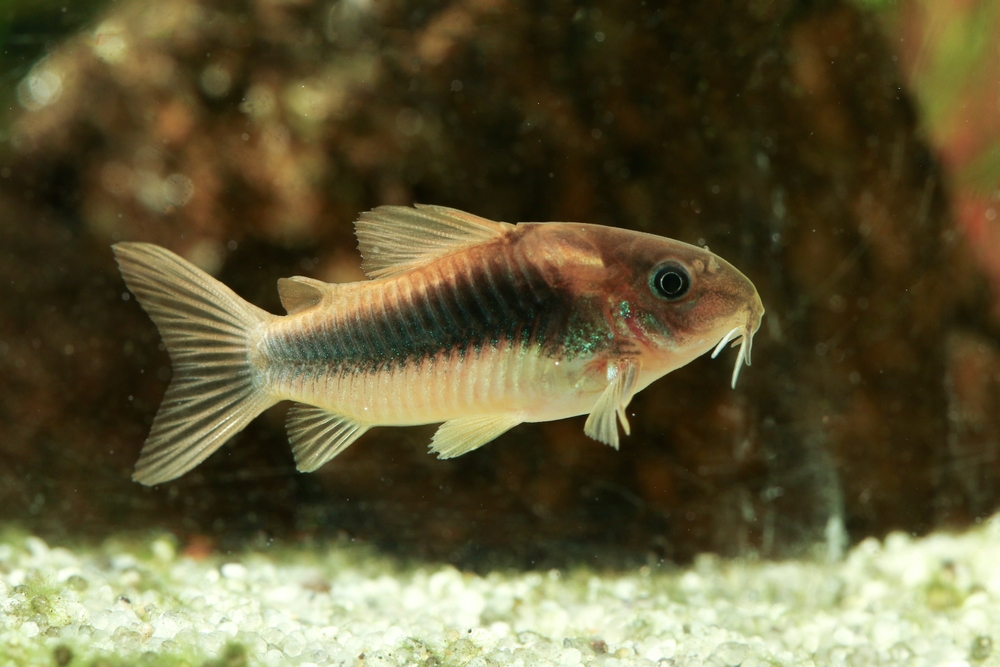Cory catfish and betta fish have garnered widespread attention among aquarium hobbyists due to their vibrant personalities and relatively easy care requirements.
These species often make an appearance in community tanks, where their differing habitat preferences allow them to coexist with minimal contention.
Cory catfish, with their peaceful nature and bottom-dwelling behavior, complement the often territorial betta fish, which typically claim the higher strata of the aquarium as their domain.

While bettas are known for their striking colors and elaborate finnage, cory catfish offer a contrasting form of beauty with their armored bodies and playful antics.
The key to maintaining harmony in a shared tank is understanding the specific needs of each species, from water conditions to dietary requirements.
Appropriate tank size, thoughtful decoration, and regular maintenance pave the way for a lively and healthy aquatic environment. Educated planning and dedicated care can result in a thriving ecosystem where both cory catfish and betta fish can flourish.
Contents
Key Takeaways
- Cory catfish and betta fish can cohabit when tank conditions meet both species’ needs.
- Balancing dietary preferences and feeding routines is crucial for their coexistence.
- Monitoring health and behavior helps maintain a harmonious aquarium environment.
Don’t miss out on these other top picks on this category:
Understanding Betta and Cory Catfish Species
In this section, we explore the specific characteristics and behaviors that define Betta and Cory Catfish species. Understanding their origins, physical traits, and typical behaviors are crucial for anyone interested in keeping these fish successfully.
Origin and Habitat
Betta, also known as Betta splendens, originated from the stagnant waters of rice paddies, canals, and floodplains in Southeast Asia. They are adapted to thrive in low-oxygen environments due to their labyrinth organ, which allows them to breathe atmospheric air.
Cory Catfish, conversely, hail from the clear streams and tributaries of South America. They are bottom-dwellers and are accustomed to a diverse array of water conditions.
Physical Characteristics
Betta splendens is renowned for its vivid colors and striking, flowing fins. Typically, males exhibit more vibrant hues and larger finnage than females.
Cory Catfish are more understated in appearance, with armored plates and a shorter, more stout body shape. They can present in various colors and patterns, including shades of brown, gray, and the albino variant.
Behavioral Traits
The temperament of Betta fish often encompasses a spectrum of aggressive behavior, especially among males, who are territorial and may spar with reflections of themselves.
On the other hand, Cory Catfish display social tendencies and prefer living in small groups. They are peaceful and are often considered ideal tank mates for Betta fish due to their non-confrontational nature.
Care must be taken in pairing these species to ensure a harmonious tank environment, recognizing the Betta’s need for space and the Cory Catfish’s schooling instinct.
Aquarium Setup and Requirements
Setting up an appropriate aquarium for both cory catfish and betta fish requires attention to specific tank conditions that cater to their needs for space, hiding spots, and water quality.
Understanding and implementing these requirements are essential for creating a harmonious environment where both species can thrive.
Tank Size and Water Conditions
For a community aquarium housing cory catfish and betta fish, a minimum tank size of 20 gallons is recommended. This space allows both species to establish their territories and reduces the chance of stress-induced behavior.
The ideal water temperature should be maintained between 72-78 degrees Fahrenheit, and a pH level between 6.5 and 7.5 is optimal, thus supporting the health and well-being of both fish varieties..
Substrate and Decorations
The substrate should consist of a smooth, sandy substrate to prevent damage to the delicate barbels of cory catfish.
Adding decorations like caves and driftwood not only enhances the aesthetic appeal of the tank but also provides necessary hiding spots to reduce stress, especially for the betta. Incorporating live plants such as anubias can contribute to the water quality while creating a more natural environment for the fish.
Filtration and Water Quality
A high-quality filtration system is critical to maintain water quality by removing excess food, waste, and helping to keep nitrate levels low. While both corydoras and betta fish require clean water, strong water currents should be avoided as bettas prefer calmer waters.
This can be achieved by using a filter with adjustable flow or by strategically placing decorations to disrupt the flow. Regular water testing and maintenance are imperative to ensure that water conditions remain stable with nitrate levels kept in check.
Diet and Feeding Recommendations
Proper feeding is crucial for maintaining the health of both cory catfish and betta fish. This section outlines the specific dietary needs and feeding habits that are essential for these popular aquarium species, as well as strategies to prevent overfeeding.
Cory Catfish Feeding Habits
Cory catfish are scavengers by nature and are considered bottom feeders. In an aquarium setting, they do well on a diet consisting of sinking wafers and sinking pellets, which mimic their natural feeding habits.
It is important to ensure that the food reaches the bottom of the tank where cory catfish can easily access it. A balance of plant-based and protein-rich foods reflects their omnivorous diet, providing all the necessary nutrients for a healthy life.
Betta Fish Dietary Needs
Betta fish, on the other hand, are primarily carnivorous and require a diet high in protein. They typically feed on the water’s surface and prefer eating flakes, pellets, and live or frozen foods like brine shrimp and bloodworms.
A balanced diet for bettas will often include a combination of these foods, which are formulated to float at the surface, making it easy for the betta fish to consume them.
Preventing Overfeeding
Overfeeding can lead to serious health issues and aquarium pollution. To prevent overfeeding, one should feed adult fish only as much as they can eat in under two minutes, typically once or twice a day.
For both cory catfish and betta fish, observing their feeding habits and adjusting portion sizes and frequency accordingly is key. Leftover food should be removed to maintain water quality and reduce the risk of overfeeding.
Compatibility and Social Behavior
When considering the compatibility and social behavior of fish in an aquarium, key aspects to keep in mind are temperament and the harmony between species. Proper tank mates can significantly influence the well-being and stress levels of the aquatic inhabitants.
Specifically, pairing betta fish, known for their territorial nature, with suitable companions such as cory catfish, which have a peaceful demeanor, requires careful consideration of their needs for space and environmental settings.
Tank Mates for Betta Fish
Male betta fish are prized for their vibrant colors and elaborate fins, but they exhibit aggression towards other males and similarly flashy fish. Suitable tank mates for betta fish must be peaceful and not prone to nipping fins.
Corydoras catfish, including varieties like bronze cory and bandit cory, are excellent companions due to their docile nature. These bottom dwellers typically do not invade the betta’s preferred upper areas of the tank.
Small, peaceful fish such as neon tetras and algae eaters like otocinclus can also be compatible, but it’s important to provide adequate hiding places to prevent stress.
- Peaceful: Ideal tank mates like cory catfish or neon tetras exhibit a non-aggressive nature.
- No Fin Nipping: Tank mates must not be inclined to nip at the betta’s fins.
- Separate Spaces: Provision of separate swimming zones helps minimize territorial disputes.
Cory Catfish in Community Tanks
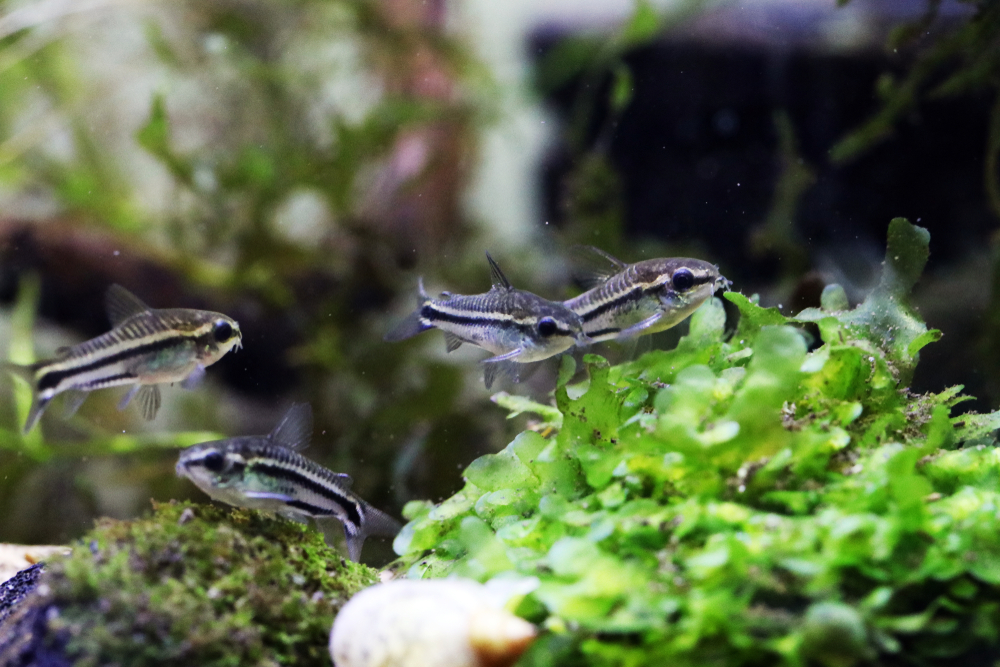
Cory catfish thrive in community tanks due to their peaceful nature and preference for company. They are often found foraging together at the bottom of the tank. Corydoras species are known to appreciate the presence of their own kind, so keeping them in groups is recommended.
While they are compatible with a range of tankmates, care must be taken to ensure that the other inhabitants are not overly boisterous or aggressive.
Besides betta fish, cory catfish can coexist with small, non-territorial fish. Shrimp can be suitable companions for cory catfish as well, but only if the shrimp are too large to be considered prey.
- Group Living: Cory catfish should be kept in groups for social comfort.
- Tank Conditions: The tank must meet specific conditions like warm, clean water with a gentle flow.
- Complementary Fish: Non-aggressive fish that do not compete with cory catfish for food or space make for good company.
Creating a harmonious tank environment requires careful consideration of the temperament and needs of the fish. Betta fish and cory catfish can be suitable tank mates under the right conditions, with both species benefiting from the presence of peaceful, non-invasive companions.
Health and Quarantine Protocols
Maintaining optimal health for betta and cory catfish involves proactive monitoring for disease and the use of isolation in quarantine tanks when necessary. Ensuring stable water conditions and monitoring ammonia and nitrate levels are critical to prevent illness.
Identifying Common Ailments
Betta fish and cory catfish are prone to different health issues. Bettas may suffer from fin rot or swim bladder disorder, signaled by torn fins or difficulties in swimming.
Cory catfish, on the other hand, are susceptible to barbel loss and skin infections, often due to poor substrate conditions or high ammonia levels. Recognizing the symptoms early can prevent severe illness.
- Betta: Watch for faded color, fin tears, or lethargy.
- Cory Catfish: Look for missing barbels, excessive mucus, or redness on the skin.
Setting Up a Quarantine Tank
A quarantine tank is a must-have for treating ailing fish or acclimating new arrivals. This tank should be separate from the main aquarium with controlled water conditions to stabilize ammonia and nitrate at safe levels. It’s critical for preventing the spread of diseases to other tank inhabitants.
Quarantine Tank Setup Checklist:
- Tank Size: Minimum of 5 gallons to accommodate individual fish, ensuring enough space for comfort and ease of water quality management.
- Water Conditions: Maintain temperature consistency with the main tank and adjust pH, hardness, and alkalinity to match specific species needs.
- Filtration: Use a sponge filter for gentle filtration that also cycles the tank, detoxifying harmful ammonia and nitrate compounds.
- Observation: Daily monitoring for behavioral changes or symptom progression, and regular water testing are essential quarantine practices.
Breeding and Reproduction
Breeding Cory Catfish and Betta fish involves distinct behaviors and requirements unique to each species. Success in breeding these fish depends on understanding and facilitating their specific reproductive habits.
Breeding Cory Catfish
Cory Catfish breeding involves a fascinating dance where the male chases the female until she is ready to lay her eggs. Once she releases her eggs, typically on the aquarium glass or on plant leaves, the male then fertilizes them.
Aquarists can encourage this behavior by replicating rainy season conditions in their aquarium through cooler water changes and increased water flow. A well-maintained tank with ample hiding spots and a soft substrate can mimic the natural habitat of Cory Catfish and support their breeding behavior.
To ensure a higher success rate, it’s essential to maintain excellent water quality and provide a diet rich in proteins to condition the breeding pairs. After the eggs are laid, they should be moved to a separate grow-out tank to protect them from being eaten by other fish, including the parents.
Betta Fish Breeding Behavior
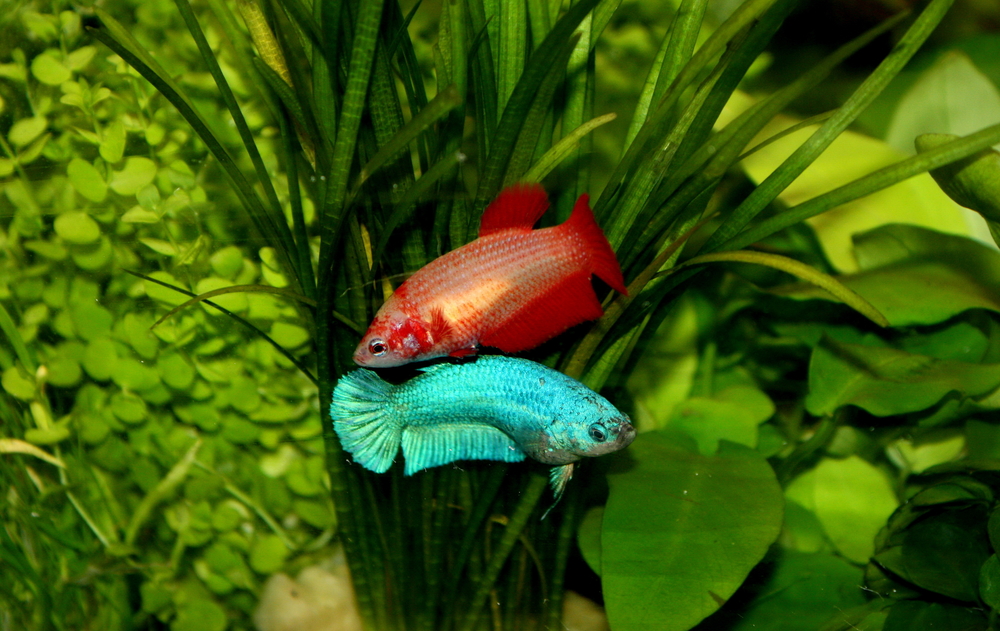
Betta breeding is a unique process, with the male Betta, also known as the Siamese fighting fish, taking a particularly active role. Once a female Betta is introduced to the breeding tank, the male will perform an elaborate courtship dance to entice her.
If receptive, the female displays vertical bars as a breeding dress. The couple then engages in a nuptial embrace, where the male wraps his body around the female to squeeze out the eggs, which he fertilizes externally.
The male betta’s responsibility intensifies as he meticulously collects the fertilized eggs in his mouth and places them into a bubble nest he has created at the water’s surface.
The bubble nest protects the eggs and keeps them oxygenated. During this period, the male becomes highly territorial and must be kept separately from the female to prevent potential aggression.
Breeding Betta fish requires a dedicated breeding tank that is tranquil and has shallow water, which makes it easier for the male to retrieve any fallen eggs.
After the fry hatch, the male continues to protect them until they can swim on their own, at which point, breeders often remove him to allow the fry to grow without parental predation.
Care Tips for Specific Cory Catfish Types
Care requirements for cory catfish can vary slightly depending on the type. Providing the appropriate conditions is essential for their well-being. Here’s how to cater to the needs of some specific types of corydoras catfish.
Peppered Cory Care
Peppered Cory (Corydoras paleatus) – These bottom-dwellers thrive in water temperatures between 72-79°F and a pH of 6.0-7.0. They prefer soft to medium water hardness, and it’s crucial to keep their environment clean as they are sensitive to high levels of nitrites and ammonia.
Panda Cory and Pygmy Cory Details
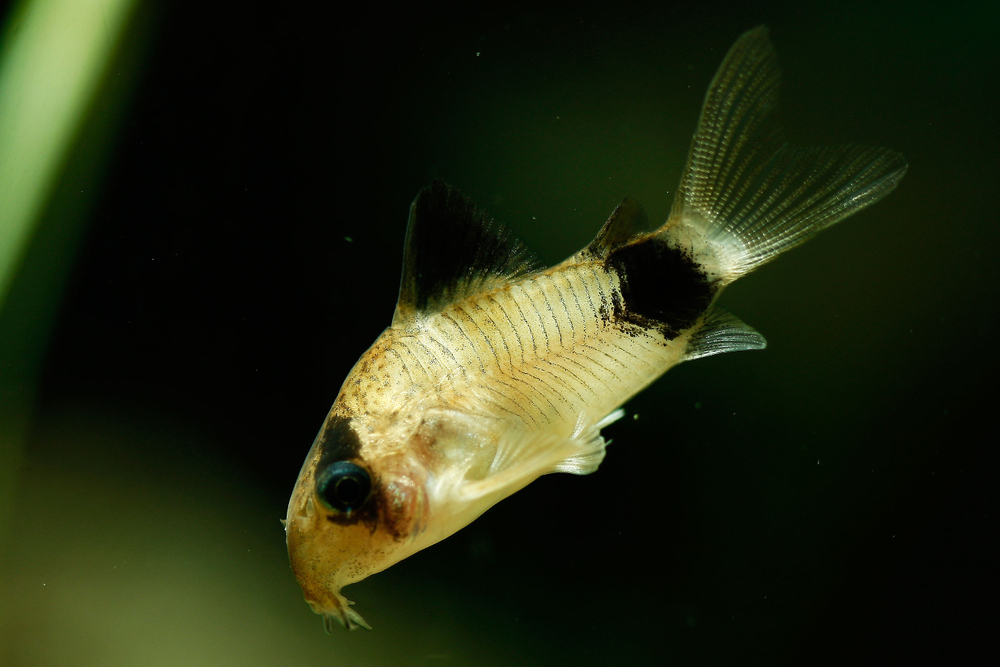
The Panda Cory (Corydoras panda) requires a slightly cooler temperature range from 68-77°F, mimicking their native habitat in Peru.
They enjoy a planted tank with plenty of hiding spots. The Pygmy Cory (Corydoras pygmaeus), one of the smallest types, does well in densely planted tanks with gentle water flow, suitable for their size and schooling nature.
Keeping Julii Cory
Julii Corys (Corydoras julii), often confused with the similar looking Bronze Corys, require a well-oxygenated tank with a soft substrate to protect their sensitive barbels.
They are best kept in groups and prefer temperatures between 73-79°F with a pH of 6.5-7.5. Regular water changes are vital to maintain their health, as they can be prone to stress in poor water conditions.
Frequently Asked Questions
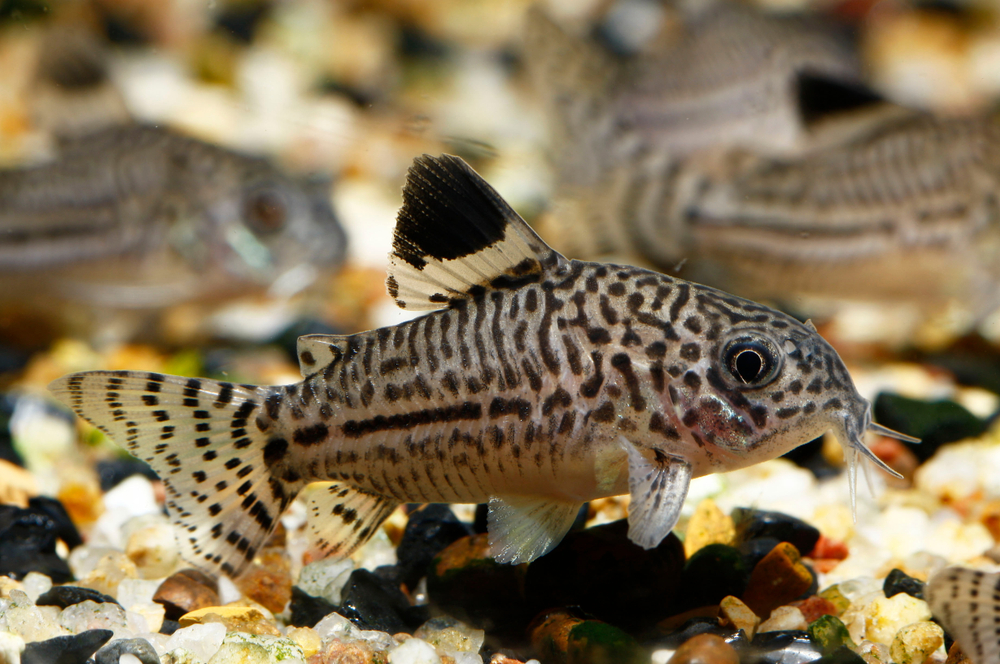
In this section, I will provide detailed answers to common inquiries about maintaining a harmonious aquarium with Cory catfish and Betta fish. Understanding these nuances is key for fostering a healthy and peaceful aquatic environment
What is the ideal tank size for housing Cory catfish with a Betta?
The minimum recommended tank size for housing Cory catfish with a Betta fish is 20 gallons. This provides enough space for the Cory catfish to scavenge and the Betta to establish its territory.
Can Cory catfish coexist peacefully with Betta fish?
Yes, Cory catfish can coexist peacefully with Betta fish. They tend to inhabit different areas of the tank, with Cory catfish being bottom dwellers and Bettas preferring the middle and top levels.
What other fish species are compatible tank mates for Cory catfish and Bettas?
Other peaceful fish species that can live with Cory catfish and Bettas include small tetras, rasboras, and certain types of dwarf gouramis. However, every fish’s temperament can vary, so careful monitoring is advisable.
What are the specific care requirements for keeping Cory catfish in a Betta tank?
Cory catfish require a tank with a soft substrate to protect their barbels, adequate filtration, and a diet rich in sinking pellets and live food. They also thrive in groups, so keeping multiple Cory catfish together is beneficial.
How many Cory catfish can be safely added to a tank with a Betta?
A group of at least 4-6 Cory catfish is ideal for keeping these social fish content. Ensure that your tank size can accommodate this group without causing overcrowding.
What should be considered when setting up a tank environment for both Cory catfish and Bettas?
When setting up a tank for both Cory catfish and Bettas, factors such as water temperature, pH levels, hiding places, and plant density should be considered for both species to thrive. Avoid sharp decorations that could harm the Betta’s fins or Cory catfish barbels.

Ian Sterling, founder of Fishlab.com, began his aquarium journey over 30 years ago, driven by a deep fascination for fish and their diverse personalities. His website, Fishlab.com, is dedicated to making fishkeeping accessible and enjoyable, offering beginner-friendly guidance, expert insights, and a community for aquarists to connect and share experiences.


